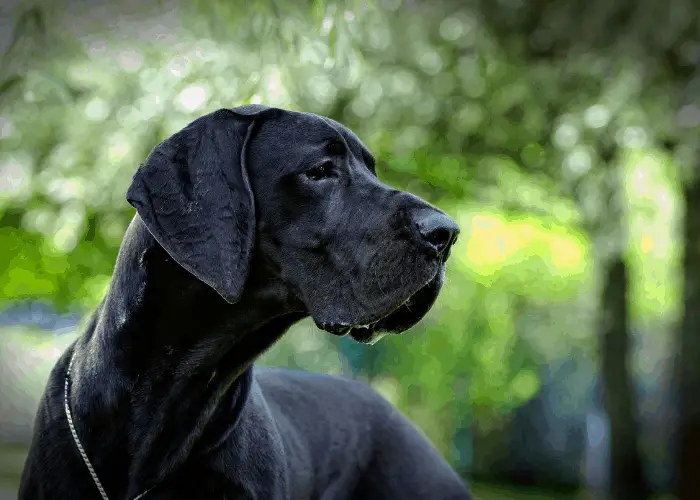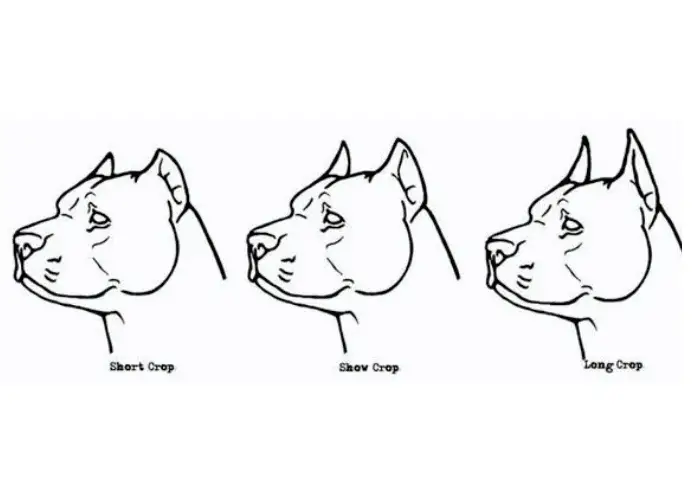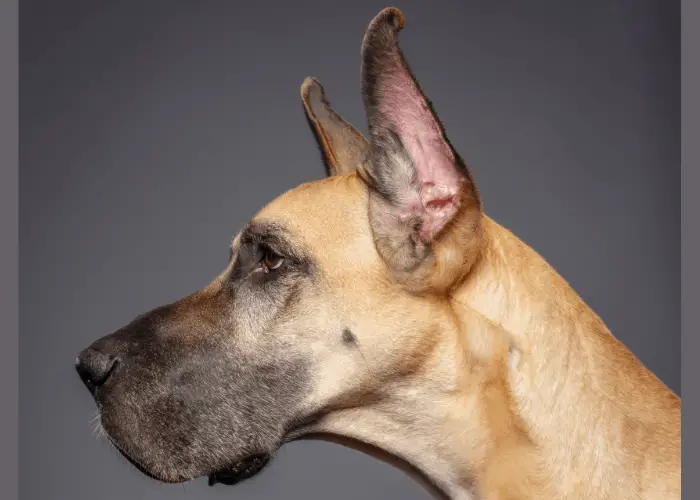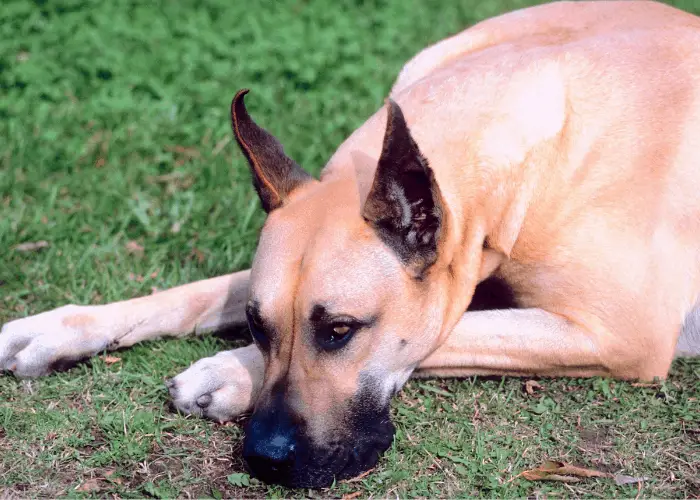Ear cropping is a practice done mainly with show dogs belonging to the Great Dane breed, and while it’s legal in some places, it may not be legal in other parts of the world.
Cropping the ears of Great Dane can also be done for medical reasons, which we’ll get into more later in the article. So, what exactly is ear cropping, and what are all the considerations that come with it?
Ear cropping is the process of partial or complete removal of the outside portion of the ear canal. This is a process commonly performed on Great Danes to enhance their aesthetic appeal, or in some cases, to help prevent medical issues. The portion of the dog’s ear that is removed is called the auricle or pinnacle.
But like we said earlier, there’s a lot more to ear cropping than that. We’re going to take a closer look at common styles, the cost of ear cropping, and the care you can expect to go along with it.
Read on to learn all you need to know about this process.
Why Do Great Danes’ Ears Get Cropped?

Ear cropping in Great Danes has been performed since the breed was first started hundreds of years ago.
The most common reason for this was to prevent a wide range of ear problems from occurring in the dog when it gets older. Because of the age factor, it’s recommended that Great Danes get their ears cropped between the age of 6 and 8 weeks.
Despite the widespread nature of this practice, many have recently called it into question, questioning whether it’s really necessary anymore with modern-day medicine and care techniques.
However, many still have this done to their dogs for aesthetic purposes, as it gives their ears a cleaner, more erect look.
Great Dane Ears: Cropped vs. Natural

While the practice of ear cropping was quite prevalent throughout the history of Great Danes as a dog breed, many have begun to disapprove of the practice in recent years.
Some feel it is a questionable and unethical practice and really has no purpose in modern times. They argue that it is cruel to crop a Great Dane’s ears, even though it may help to prevent infection and irritation.
Because a Great Dane’s natural ears are long and floppy, many owners of these dogs may want to get their ears cropped to appear more pointed and erect. Others prefer the floppy, natural look of uncropped ears.
While ear cropping can help to prevent various health issues for these dogs, it’s largely optional today and based on whether or not you like the look of natural Great Dane ears. You may want to consider the ethical side of things too.
At What Age Should You Get a Great Dane’s Ears Cropped?

A specific age range should be respected when cropping a Great Dane’s ears, as cropping them too soon or too late in their physical development can cause problems.
You’ll want to make sure to have their ears cropped between the ages of 6 and 8 weeks old. This is the best time to get them cropped because this is when their ears have already formed fully but have not yet grown to their full size.
If cropped later than 10 weeks of age, cropping of the ears could lead to misshapen or malformed ears and cause immense pain for the dog.
The same might happen if you crop their ears too early when they have not had sufficient time to be fully formed yet. It’s safest to crop their ears in the designated time window, which again, is between 6 and 8 weeks of age.
What is the Cost of Cropping a Great Dane’s Ears?
Ear cropping can oftentimes be quite expensive, as it takes a skilled and well-trained vet to properly perform the cropping. However, this cost may be worth it to some Great Dane owners, as the aesthetic and health benefits are too great for some to pass up.
If you’re looking to get a Great Dane’s ears cropped, you can expect to pay around $500 to $600 for the procedure. This is just an approximation of the cost; you may find differing prices based on the vet you go to and the location. But this price range is pretty safe.
Great Dane Ear Cropping Styles

There are many different ear cropping styles to choose for your Great Dane, many of which have become distinct styles over the centuries.
Each of these popular styles will give your Dane a distinct look compared to other dogs, so choosing the right style is more important than you might think. Let’s look at some of the most common and popular ear cropping styles for Great Danes:
Pet Crop
Also called the medium crop, the pet crop is a conservative ear cropping style that leaves the Great Dane’s ears at a medium length. This is one of the shortest styles of ear cropping, and as such, it’s also one of the easiest to care for.
However, this is actually one of the hardest styles to crop in, so make sure you find a properly trained vet to take care of the cropping if this is the style you choose for your dog.
Long Show Crop
Many view the long show crop as the most stylish kind of ear cropping, and this style is given to many Great Danes who also show dogs.
This style will leave the Dane’s ears tall and pointed, giving them an alert and regal appearance. This style also leaves the dog’s ears at the maximum length possible for ear cropping, making it harder to maintain.
The long show crop is known to be a tricky style to crop correctly, and as such, there is an increased possibility that a Great Dane’s ears may not stand up properly after having the procedure done. Just something for the interested Great Dane owner to consider.
Medium Long Crop
Another of the longer ear cropping styles, the medium-long crop leaves your Great Dane with an appearance between the pet crop and the long show crop. Not quite as tall or long as the long show crop, their ears will still stand much taller than those with a pet crop.
The main difference between the previous style and this one is the length of the ear tip, which is considerably shorter in a medium-long crop. The good thing about this is an increased chance of their ears standing properly after undergoing the cropping procedure.
After Care Instructions for After Ear Cropping
It will be very important to follow a strict after-care routine for your Great Dane after their ears have been cropped. This will help prevent infection, irritation, or incorrect healing of their ears.
- When the puppy’s sutures have been removed, and their ears retaped, they should be kept away from other dogs to prevent them from licking the ears and reopening the incisions. This could result in them healing wrong, or in the formation of excessive scar tissue.
- In between when the sutures are removed and their ears get retaped, make sure to gently massage the edges of their healing ears twice a day. You can use Vaseline as a lubricant. This will help in the healing process.
- Try not to play excessively with the puppy, as this may cause their ears to be put down more than usual. This could result in tearing of the incisions on their ears and may keep their ears from standing up properly after healing.
- If your puppy is not perking its ears up enough, use a dog whistle to get its attention a few times a day.
- Keep their ears as dry as possible, as continually wet ears will have a more difficult time standing.
- If your dog is scratching their ears while they’re trying to heal, try giving them half a tablet of a 5-grain Aspirin. Do not give them acetaminophen, as it’s toxic to dogs.
- You can also try to put socks over the puppy’s rear feet to prevent them from scratching at the ear incisions.
Pros and Cons of Cropping Great Dane Ears

As discussed in the previous section, various pros and cons are associated with cropping a Great Dane’s ears.
Pros include keeping their ears up and pointed away from the ground, which can help immensely in preventing infection, irritation, and skin rashes.
These problems may occur in uncropped ears because they will drag on the ground or across other contaminants when the dog is sniffing around or eating.
As far as cons go, many view ear cropping as a barbaric and unnecessarily cruel process, causing unneeded pain to these gentle giants. As such, you may face an ethical dilemma when deciding whether or not to crop a Great Dane’s ears.
Cropping their ears will make it impossible for them to keep their natural appearance, as uncropped ears are naturally long and floppy instead of erect and pointed.
When considering whether or not you want to crop your Great Dane’s ears (if this is a consideration you ever have to make), you may want to consider these pros and cons. Do you prefer the more manicured look of cropped ears, or do you prefer the natural floppy look of their normal appearance?
Are you worried about their ears getting infected? These are all important to consider when making your decision.
Final Thoughts

The typical erect and pointed shape of a Great Dane’s ears is not natural. This shape is achieved through the process of ear cropping.
Ear cropping involves removing portions of the ear to make it stand on end and appear pointed, instead of hanging low and floppy as is natural. This has been a popular practice for centuries, truly ever since the breed was first started.
However, despite the widespread use of this procedure, some find it unnecessary and cruel in modern times.
While it can help prevent infection and irritation, ear cropping is largely an optional procedure that has more aesthetic benefits than health benefits.
Remember to consider all the information we’ve outlined for you above to decide whether or not ear cropping is right for your Great Dane.
Check Out the List Of Famous Great Danes Below:

